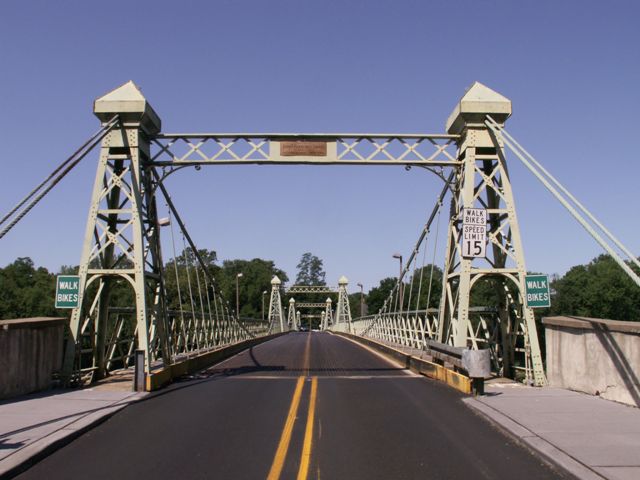We Recommend:
Bach Steel - Experts at historic truss bridge restoration.
BridgeHunter.com Phase 1 is released to the public! - Visit Now
Riegelsville Bridge

Primary Photographer(s): Nathan Holth and Rick McOmber
Bridge Documented: July 11, 2008
Riegelsville: Warren County, New Jersey and Bucks County, Pennsylvania: United States
1904 By Builder/Contractor: John A. Roebling Sons Company of Trenton, New Jersey
2010
200.0 Feet (61 Meters)
577.0 Feet (175.9 Meters)
15.7 Feet (4.79 Meters)
3 Main Span(s)
9741799910005

View Information About HSR Ratings
Bridge Documentation
View Archived National Bridge Inventory Report - Has Additional Details and Evaluation
Visit Delaware River Joint Toll Bridge Commission's Page For This Historic Bridge
This bridge is a very unique and historically significant bridge. Its design is unusual because it contains multiple, relatively short suspension spans. Most suspension bridges that are familiar today are much larger bridges that contains only two suspension towers. This bridge contains four. This bridge has unusual and original floorbeams that have post-tension bars built underneath the main built-up beams. Riegelsville Bridge also includes lightweight double-warren stiffening truss. The bridge is also noteworthy and significant for association with the bridge company formed by one of the most famous suspension bridge builders, John Roebling.
This bridge is owned by the Delaware River Joint Toll Bridge Commission (DRJTBC). The DRJTBC has a unique commitment to maintaining the many historic bridges under its ownership, and working with the communities the bridges serve, and sets an example for the rest of the country to follow. The front page of their website often features a photo of a historic bridge, and their slogan is "Preserving Our Past, Enhancing Our Future." How many other road/bridge agencies in the United States promote their commitment to historic bridges in this way? Not many.
Not only is the DRJTBC an example of how money might be better spent in regards to non-toll bridges, the DRJTBC bridges are also a great reference when arguing that a historic bridge can be rehabilitated and can also safely continue to function as a vehicular crossing.
In 2010, this bridge was rehabilitated. The bridge received structural repairs, a fresh coat of paint, and other improvements. Low visual impact cable railings were added to the bridge, mounted on the stiffening truss. The engineering firm for the rehabilitation was Ammann and Whitney and the on-site contractor was Neshaminy Constructors, Inc.

Information and Findings From Pennsylvania's Historic Bridge InventoryDiscussion of Bridge The 3-span cable suspension bridge supported on ashlar piers from earlier bridges was placed in 1904 to replace one lost in the great 1903 flood. The floor beams have kingpost post tensioning, which appears to be an original detail. When the bridge was completed, Prof. J.M. Porter of Lehigh Univ. questioned the adequacy of the design, and two, 1 3/4" cables were added to provide additional support. The bridge was made free in 1923, and it is owned by the Delaware River Joint Toll Bridge Commission. The bridge was sensitively rehabilitated in 1984. The bridge is significant for its type and association with the Roeblings, and it is located in and contributing to a potential historic district. Discussion of Surrounding Area The bridge carries a two lane road over the Delaware River connecting the Pennsylvania and New Jersey portions of Riegelsville. The historic Riegel paper mill is on the east side of the river. Riegelsville is a potential historic district, on both sides of the river, and the bridge would be a contributing resource to it. Bridge Considered Historic By Survey: Yes |
![]()
Photo Galleries and Videos: Riegelsville Bridge
Bridge Photo-Documentation
Original / Full Size PhotosA collection of overview and detail photos. This gallery offers photos in the highest available resolution and file size in a touch-friendly popup viewer.
Alternatively, Browse Without Using Viewer
![]()
Bridge Photo-Documentation
Mobile Optimized PhotosA collection of overview and detail photos. This gallery features data-friendly, fast-loading photos in a touch-friendly popup viewer.
Alternatively, Browse Without Using Viewer
![]()
Maps and Links: Riegelsville Bridge
Coordinates (Latitude, Longitude):
Search For Additional Bridge Listings:
Bridgehunter.com: View listed bridges within 0.5 miles (0.8 kilometers) of this bridge.
Bridgehunter.com: View listed bridges within 10 miles (16 kilometers) of this bridge.
Additional Maps:
Google Streetview (If Available)
GeoHack (Additional Links and Coordinates)
Apple Maps (Via DuckDuckGo Search)
Apple Maps (Apple devices only)
Android: Open Location In Your Map or GPS App
Flickr Gallery (Find Nearby Photos)
Wikimedia Commons (Find Nearby Photos)
Directions Via Sygic For Android
Directions Via Sygic For iOS and Android Dolphin Browser
USGS National Map (United States Only)
Historical USGS Topo Maps (United States Only)
Historic Aerials (United States Only)
CalTopo Maps (United States Only)



